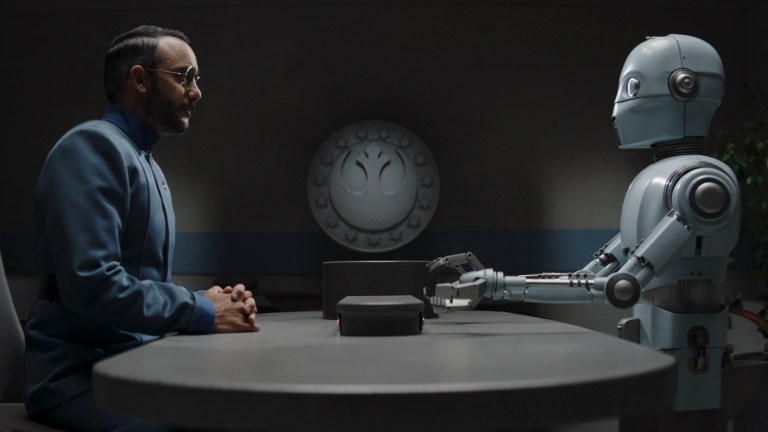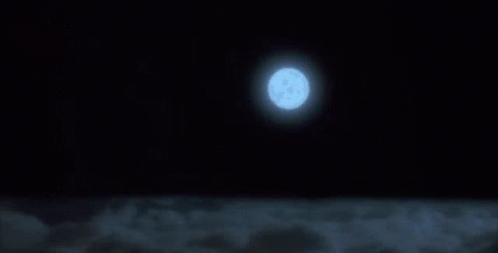Star Wars: The Mandalorian Season 3 Episode 3 Easter Eggs Explained
The Mandalorian Chapter 19, "The Convert," features plenty of easter eggs, callbacks, and references to other parts of the Star Wars universe!

This Star Wars article contains spoilers for The Mandalorian.
The latest episode of The Mandalorian, “The Convert,” features plenty of scene-setting and world-building, as fans get to go back to Coruscant to visit with former Imperial agents Dr. Pershing and Elia Kane, while Din and Grogu take a break at the Mandalorian covert. Their true allegiance may be in question, but the amount of easter eggs and references scattered throughout this episode certainly is not. There’s so much great lore in “The Convert,” while also managing to set the stage for much bigger things to come for season 3.
Here are all the Star Wars callbacks, easter eggs, and references we found in Chapter 19 of The Mandalorian:
Elia Kane (Katy O’Brian)
Katy O’Brian returns as former Imperial communications officer Elia Kane, although how “former” she actually is remains to be seen. While she totally plays Dr. Pershing in service to the New Republic, it seems she may actually be a double agent, still working for Moff Gideon, and orchestrating events that will lead Pershing back into the Empire’s clutches. Digging the spy vibes, either way.
Dr. Penn Pershing (Omid Abtahi)
We learn Dr. Pershing’s first name is Penn and that the reason he’s devoted his life to experimenting with cloning is because he believes the research could save people’s lives. He wants to use cloning to make advancements in medicine, but the Empire twisted that for its own means (probably cloning the Emperor). By the end of the episode, Pershing is in pretty bad shape, as he undergoes a grotesque electroshock procedure at the hands of the New Republic (although it’s really Elia Kane who turns up the electrical current, which means this might actually be part of Gideon’s plan to get the doctor to defect back to the Empire).
Coruscant and the Core Worlds
Somehow, Coruscant returned! Everyone’s favorite city planet is best known as the setting of much of the Prequel Trilogy, especially Revenge of the Sith, but it was actually first introduced in the pages of the classic Marvel Star Wars comics, specifically issues #61 and 63 from 1982. That said, the Imperial Capitol wasn’t properly named “Coruscant” until Timothy Zahn’s seminal Legends novel Heir to the Empire.
George Lucas flirted with the idea of a planet called Coruscant long before these Expanded Universe stories, though. Alderaan was called Coruscant in early drafts of A New Hope, and Lucas almost included an Imperial city in The Empire Strikes Back and Return of the Jedi, too. The planet finally made its big screen debut in the 1997 Special Edition director’s cut of Return of the Jedi (during the celebration scenes at the end) before getting a more prominent appearance in The Phantom Menace.
Coruscant is located in a region of space known as the Core Worlds, which is the seat of power of the galaxy, containing the wealthiest planets, no matter which faction is ruling it. It should be noted that at this point in the Star Wars timeline, five-ish years after Return of the Jedi, Coruscant isn’t actually the capital of the galaxy anymore. Instead, the central government of the New Republic is Chandrila, Mon Mothma’s home world. The New Republic actually established a rule where the capital changes every couple of years for reasons. You’ll remember that in The Force Awakens, which is set some 30 years after Return of the Jedi, the New Republic capital is the doomed Hosnian Prime, which is blown to smithereens in that movie.
TIE Interceptors, Bombers, and Imperial Star Destroyers
Lots of Imperial ships return in “The Convert”…
– Bo-Katan’s Gauntlet starfighter faces off against TIE interceptors in the opening combat sequence. These are upgraded versions of the standard TIE fighters, built for speed and outfitted with way more firepower. They’re basically designed to prey on weaker ships, which they do here. This design first appeared in Return of the Jedi.
– TIE bombers destroy Bo-Katan’s castle, leaving her both without a clan and homeless. Their purpose is basically in the model name: TIE bombers are much slower than other Imperial starfighters but carry much more devastating payloads. They were actually first introduced in the classic Marvel Star Wars comic issue #12 from 1978, although you may remember them best from The Empire Strikes Back.
– Last but certainly not least is the classic Imperial Star Destroyer that Pershing and Kane sneak into in the Coruscant junkyards. While this particular battleship is being dismantled by the New Republic, Star Destroyers are best known as the capital ships of the Imperial fleet. They’re also one of the oldest ships in Star Wars movie history, having been introduced in the very first scene of A New Hope.
A Little Batman ’89 Homage?
This may just be us, but it definitely looks like the episode sneaks in a little homage to the Batplane scenes from Tim Burton’s Batman. In one combat sequence, Mando pilots his Naboo Starfighter straight up into the air, with the camera tracking its ascent. When it reaches a certain altitude, the ship brakes for a beat, seemingly floating in place high above Kalevala, before Mando lets the ship slowly drift back down to get the drop on enemy fighters. Doesn’t that look just like the famous “Bat eclipse” shot from Batman sans moon backdrop?

Galaxies Opera House From Revenge of the Sith
Dr. Pershing gives his speech about cloning to a crowd of New Republic elite at the Galaxies Opera House. This is the same concert venue from Revenge of the Sith where Supreme Chancellor Palpatine first told Anakin Skywalker about the tragedy of Darth Plagueis of the Wise. That time, they were actually watching the opera, not a mad scientist talking about the benefits of kidnapping Baby Yodas for the good of the galaxy.
Kaminoans, Cloning, and Strand-Casts
During his speech, Dr. Pershing makes references to the Kaminoan cloners first introduced in Attack of the Clones. They were of course responsible for creating the Grand Army of the Republic from Jango Fett’s DNA. We learn in The Bad Batch animated series, which takes place decades before The Mandalorian, that the Empire destroyed those Kaminoan cloning labs right after the Clone Wars.
Pershing also mentions “strand-casts,” which are apparently imperfect clones or some mumbo jumbo introduced in The Rise of Skywalker. We’re not going to try to pretend to know how the fake space science works, but this strand-cast research in the hands of the Empire is pivotal to creating a perfect clone vessel for Emperor Palpatine. Moving on.
Mon Calamari and Admiral Ackbar Reference
Several Mon Calamari are featured in the episode. The most famous member of this race to Star Wars fans is of course Admiral Ackbar from Return of the Jedi. The episode actually features a fun little homage to the Admiral when Pershing yells at the Mon Calamari mind flayer quack that he was caught “in a trap!” We don’t have to tell you what that’s in reference to, right?
Coruscant Accords and New Republic Tribunal
A bit of New Republic law tidbits being thrown around in this episode:
– The Coruscant Accords seems to be the name for the laws of the New Republic as a galactic entity. One of these rules, as Dr. Pershing learns, is no cloning or genetic engineering allowed. In Legends, the Coruscant Accords were the set of rules planets needed to follow to join the Old Republic.
– One former Imperial soldier mentions a rumor that Moff Gideon escaped before having to face the New Republic War Tribunal, which is the court where Imperial war criminals are tried and convicted for their heinous crimes. This special court established to punish Imperials was first mentioned in Legends continuity and was reintegrated into canon in the novel Aftermath: Life Debt by Chuck Wendig.
Mind Flayer
One of the punishments for crossing the Empire or the New Republic seems to be the Mind Flayer, some sort of electroshock therapy meant to torture prisoners, even though that Mon Calamari quack on Coruscant assures Pershing it isn’t used like that by the new and “benevolent” galactic government.
Fun fact: this device gets its name from one of the most feared monsters in the Dungeons & Dragons universe.
Skydome Botanical Gardens
The Skydome Botanical Gardens is one of the many sights on Coruscant that Dr. Pershing learns about from that overly helpful taxi droid. This location was first introduced in the Legends novel Jedi Search by Kevin J. Anderson in 1994.
Umate
Umate is one of the highest mountains in Coruscant and the only original natural landmark still visible after the mass industrialization of the planet. Citizens can only really see its peak at this point. This landmark was first mentioned in Legends, but these days you might know it best from an early scene in the novel The High Republic: Light of the Jedi by Charles Soule. Supreme Chancellor Lina Soh liked to visit this landmark during times of trouble in the centuries before the Skywalker Saga.
Benduday and Taungsday
Yes, the Star Wars galaxy has its own days of the week! Five days to be exact: Primeday, Centaxday, Taungsday, Zhellday, and Benduday. There are seven weeks in a standard galactic month and 10 months in a standard year.
Taungsday is apparently a rough day of the week (and yeah, Wednesdays do kind of suck) and named after the Taung, a humanoid species that once existed on ancient Coruscant. Benduday is named after the Bendu monks, an order of ancient Force worshippers who were the precursors to the Jedi. George Lucas originally referred to Kane Starkiller and his ilk as “Jedi Bendu” warriors in the very early drafts of A New Hope.
Mantabog of Malastare
First introduced in the Star Wars Roleplaying Game by Wizards of the Coast in 2003, the Mangtabog seems to have been some kind of snake-like creature before it went extinct. You can still find a hologram of this species at Coruscant’s Holographic Museum of Extinct Animals, though.
Resistance Theme Song at the Carnival
While Pershing and Kane visit the carnival surrounding Umate, you can hear a band playing John Williams’ “March of the Resistance” Theme” theme from the Sequel Trilogy.
Travel Biscuits
Pershing and Kane both remember those dry-looking travel biscuits fondly. These were standard rations for Imperial personnel and go all the way back to Legends.
Photon Fizzle
While on Coruscant, cool off with a photon fizzle, one of the planet’s signature cocktails. It’s green in color and contains little floating edible orbs that might make you think of real-world bubble tea. You could find this drink at Dex’s Diner in Attack of the Clones, although it was first mentioned in the Droids animated series in 1985.
Twi’lek and Bufopel
Since we’re on Coruscant for most of the episode, and the planet is the central social hub of the galaxy, it’s no surprise we encounter lots of different species while touring city streets. While we see Barbadelans, Frigosians, Ishi Tib, Ithorians, Mimbanese, Pantorans, and Rodians, let’s give a special shoutout to Bufopel and Twi’leks, who appear most prominently in “The Convert.” Twi’leks were of course introduced in Return of the Jedi, while Bufopel first popped up in The Last Jedi.
